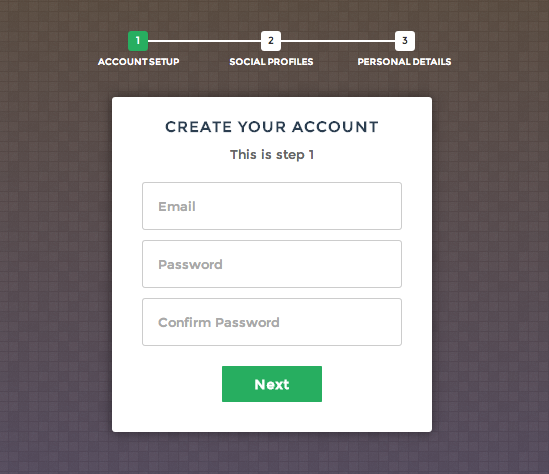How to Sell Your Client On a Better Converting Type of Form
You’ve heard the old adage: The client is always right.
But every so often there comes a time when you – the designer or developer – know that there’s a better way. After all, you work with websites on a daily basis, and you see how well things convert or don’t convert. You have years of experience under your belt to know that sometimes certain methods work better than others.
So when a client says, “We want it this way,” there may come a time when you have to respond, “Well actually, here’s another suggestion…”
When it comes to creating forms in particular, some form types just work better than others for certain audiences. And if your gut is telling you that a full-page form would work better, then that’s what you should go with.
But how do you tell that to your client?
Here’s how to sell them on a better way, even if they’re picky.

Certain Forms Work Better Than Others
According to the B2B Technology Marketing Community, “61 percent of B2B marketers struggle to generate high quality leads.” Forms play a big role in that struggle, and in some ways, designers and developers have an inside scoop on which forms work better than others.
Generally that’s because you’re the one stuck doing a redesign when conversions are low. And it’s true that some forms convert better than others.
For instance, forms shown above the fold can improve conversion rates, but sometimes only for audiences that are already familiar with the client’s brand.
According to Smashing Magazine, short forms or progressive forms work much better for mobile users, while Convert With Content suggests using multi-step forms instead of long forms because they work better for those needing more information without sacrificing conversions.

While you may not have it all memorized off the top of your head, chances are that you know from experience which forms will work in context and which ones don’t. (It’s okay to trust your gut, too).
Of course, once you realize that the form types your client wants may not be the best solution for their audience (or even for their site’s design), it comes time to suggest something different. So how do you do that, exactly?
How to Convince Them You’re Right
Your primary job is really to keep the client happy, but as much as possible you should try to make sure that your client’s endeavors are successful.
While that can be hard to do with a client that is picky or demanding (they simply must have their way), it is possible to suggest an idea that (you feel) will help them achieve their results faster. But you don’t want to come across as a know-it-all, or you’ll risk bruising their ego.
Here are a few ways to try to get your point across without sounding like a demanding diva.
Speak from Experience
While your client has expertise in their respective field, and they probably know their audience better than you, that doesn’t mean you don’t know what you’re talking about. After all, you work with forms and websites, and you’ve had clients come back and say “Hey, this isn’t working, can we change this?”
You’re an expert, and you need to own it. More importantly, you need to show that your opinions have merits. If you want to suggest a new idea, you’ll have to show them that you have their best interests at heart. Which leads to…
Show, Don’t Tell
If you can show how a different form type improved another client’s conversions – whether from your own experience or from an article or post you read about – and you know that your current client has a similar audience, it’s a good idea to grab that data and have it handy.
It can also be helpful for a client to see exactly what you’re suggesting to avoid any confusion. Create a mockup of how the new form would work, and show them step-by-step why it will work better for their audience so they have actual social proof to consider while making decisions.

Keep It Consistent
If you’re suggesting something that may be totally out of left field, you still want to reassure them that you understand their audience and brand. Again, this is where a mockup can help, showing the form in action while using their images and site design as a backdrop.
But even if your form idea is way out there, do as much as you can to stick to their audience. If they use business-formal language, don’t start their forms with “Howdy, y’all!” If their colors are blue and gold, don’t design a form that’s purple and grey. It should be a no brainer, but as much consistency as you can keep, the better your “crazy” idea will go over, especially with picky clients.
Offer It Like an “Upgrade”
Sociologist Alvin Gouldner says that no society on earth can escape from reciprocity, or the idea that if someone’s giving you something of value, you should return the favor. Consider suggesting the changes as if you’re providing an exclusive service above and beyond the norm, and they may feel obligated to say yes just because you’re offering.
“We’ve offered this to a few of our other clients and they’ve seen much higher conversions than the standard form. We notice you have a similar audience, would you like to try this new form type? We can create a mockup if you’d like to see it.” More often than not, your client will at least consider your idea rather than rejecting it outright.
Don’t Be Rude
Finally, presentation is everything. This should go without saying, but if you’re rude to the client, they will be primed to reject anything you say on the sheer principle of you being unlikable. While business professionalism can go a long way, it’s about balancing the authoritative tone of an expert with the courtesy of a customer service representative.
According to Call Proof, it’s about listening, empathizing, and under-selling. You have to see your client as more than just a dollar sign, and treat them as you would your family or friends.
Final Thoughts
Sometimes you have a feeling that a different type of form will work better than others with the client’s design or will generate more leads. Since you have some experience to back up your ideas, you want to suggest those changes to your client.
If you’re looking to convince a client that your idea has merit, be sure to present yourself like an expert. Use data and as much information as you can, and create a mockup so they can see exactly what you’re talking about.
Make sure it stays consistent with their branding and actually helps them. You can do this by offering it up as something that will genuinely add value to their business.
And, above all, communicate like a customer service rep – listen, engage, and don’t forget to play nice. Soon your clients will be falling over themselves to implement your awesome new ideas.